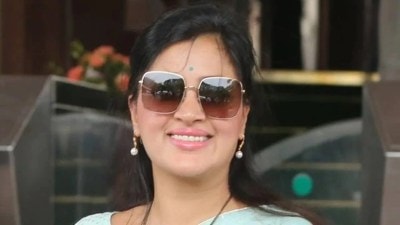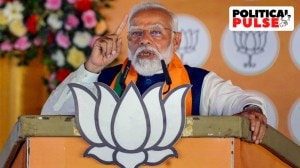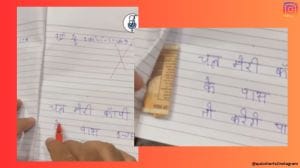- India
- International
In pandemic year, 88% school kids got access to smartphones in Punjab, 82% in Haryana
In the report, Kerala emerged at the top with 94.3 per cent children having access to smartphones, while for West Bengal this figure was just 47.4 per cent placing it at the bottom of the table among the states surveyed.
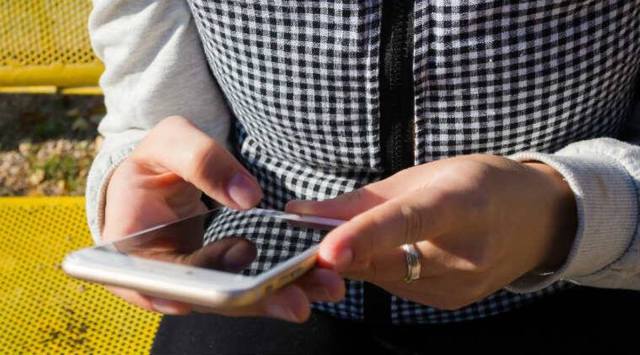
With smartphones emerging as a key tool for imparting education in times of the pandemic, the Annual Status of Education Report (ASER) for Rural India conducted amid an unprecedented school shutdown has revealed that a little above 88 per cent children surveyed in Punjab (government & private schools combined) had access to smartphones, compared to 90 per cent in Himachal, 82.3 per cent in Haryana and just 77.1 per cent in Jammu and Kashmir.
In the report, Kerala emerged at the top with 94.3 per cent children having access to smartphones, while for West Bengal this figure was just 47.4 per cent placing it at the bottom of the table among the states surveyed.
Focus on remote learning
The annual report — ASER 2020 (Rural, Wave 1) — by the ASER Centre, the autonomous research and assessment unit Pratham Education Foundation, was released Wednesday. It is the first ever phone-based ASER survey.
Conducted in September 2020 amid the Covid-19 pandemic and lockdown when schools remained closed for at least six months, the survey explored provision of and access to distance education mechanisms, materials and activities for children in rural India, and the ways in which children and families are engaging with these remote learning alternatives from their homes.
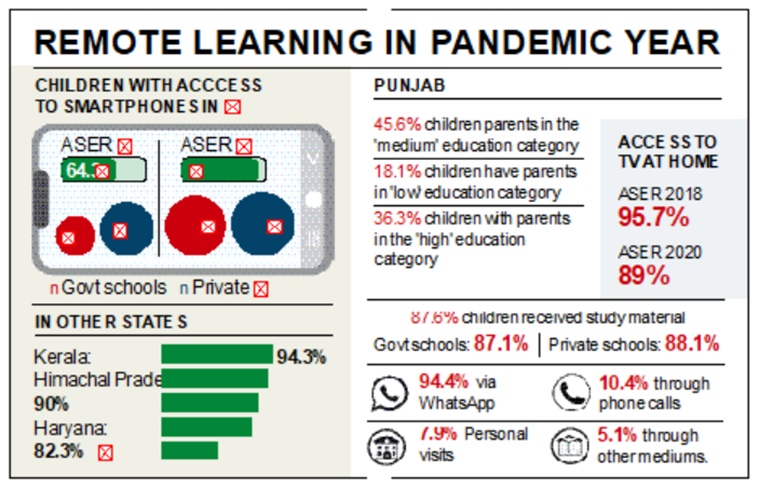
ASER 2020 was conducted in 26 states and 4 Union Territories. It reached a total of 52,227 households and 59,251 children in the age group of 5-16 years, as well as teachers or head teachers from 8,963 government schools offering primary grades.

In Punjab, the survey was conducted covering 595 villages from 20 districts and 2,434 households were surveyed with information collected via phone calls. A total of 2,010 children were reached from 5-16 years of age in Punjab. Among these, those who were enrolled in schools included 315 from Class 1-2, 475 from Class 3-5, 536 from Class 6-8 and 516 from Class 9 to 12.
Further, 1.5 per cent children from age 6-14 and 1.8 per cent children from age 7-16 were found not enrolled in any schools in Punjab.
What survey reveals for Punjab
The highlights for the survey result in Punjab showed that overall 88.4 per cent of the children surveyed had smartphones in their households.
The number of children having access to smartphones in Punjab has significantly increased from 2018, the report pointed out. While in 2018, only 47.3 per cent children from government schools and 79.8 per cent from private schools had access to smartphones (overall 64.3%), this figure has increased to 83.3 per cent for government school students and 93.7 per cent for private school students (overall 88.4 per cent) in 2020. This increase is primarily indicating the need of smartphones for education that arose due to Covid-19 and studies going online.
Further, 18.1 per cent of children had parents in ‘low’ education category (where parents have completed Class 5 or less or no schooling).
Of these 18.1 per cent children, 75.8 per cent lived in households with smartphones and 79.5% were enrolled in government schools.
Another 45.6 per cent had parents in the ‘medium’ education category. Of this, 86.4 per cent lived in households with smartphones and 59.1 per cent were enrolled in government schools. For the 36.3 per cent children with parents in the ‘high’ education category, 97.3 per cent had access to smartphones and only 24.7% out of them were enrolled in government schools.
Interestingly, the access to television among students has declined. While according to ASER 2018, 95.7 per cent children had access to televisions in their homes, it has declined to 89 per cent in Punjab in 2020. Access to a motorized vehicle is almost the same as in 2018 at 77.6 per cent.
Access to study material in Covid year
Also, 96.1 per cent students in Punjab from government schools and 95.9 per cent from private schools were found having access to their textbooks for the current grade.
In another interesting statistic, 73.8 per cent children in Punjab enrolled in schools were found receiving help from family members while studying at home, including 67.8 per cent in government schools and 79.9 per cent in private schools.
In Punjab, a total of 87.6 per cent children were found receiving study material including 87.1 per cent from government schools and 88.1 per cent from private schools.
Of this, while 94.4 per cent received study material via WhatsApp, 10.4 per cent got through phone calls, 7.9 per cent through personal visits and 5.1 per cent through other mediums. Overall, 93.7 per cent children from government schools and 95.1 per cent from private schools got the material through WhatsApp.
For the children who were enrolled in schools but still did not receive study material in Punjab during the lockdown, parents listed several reasons such as schools not sending material, no access to smartphone or internet, connectivity/network issues and others.
Contact with teachers takes a hit
Households were also asked about contact of their children with the teachers during lockdown.
In Punjab, of children enrolled in government schools, 74.9 per cent children’s teachers had visited or called the parent/child, and 60 per cent children or their parents had visited or called the teacher. Of those who had no contact, 61.9 per cent children/parents and teachers had called or visited each other at least once since the lockdown began to discuss learning materials/activities or child’s progress/wellbeing.
Similarly, 74.7 per cent children’s teachers and parents had contacted each other at least once since the lockdown began for administrative purposes. Overall for both government and private school students in Punjab, 71 per cent children’s teachers visited/called their parent or child during the reference week when the survey was conducted.
Apr 16: Latest News
- 01
- 02
- 03
- 04
- 05











